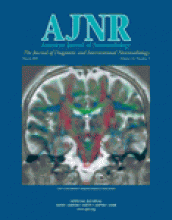As you ramble on thru Life, Brother, Whatever Be your Goal, Keep your Eye upon the Doughnut, and Not upon the Hole.
—The Optimist’s Creed
Aneurysms of the intracranial arteries are a significant source of morbidity and mortality and a significant part of the neuroradiology literature is dedicated to the analysis and evaluation of various methods of diagnosing and treating cerebral aneurysms and their associated comorbid complications. Much of the advanced training in neuroradiology is dedicated to acquiring the skills necessary to safely perform diagnostic and therapeutic endovascular procedures for the treatment of cerebral aneurysms, and newer training pathways have been developed to hone this therapeutic skill to a finer edge. It could be reasonably stated that the neuroradiologist is the fulcrum of the diagnosis and management of cerebral aneurysms.
Ever since Egas Moniz first demonstrated the intracranial arterial tree with a contrast injection in the carotid artery, angiography has been the mainstay of the diagnosis of cerebral aneurysms. It is often referred to as the gold standard or criterion standard by which any other method of diagnosis is measured. Although it is well accepted that, like any imaging study, angiography has its share of false-negative results, its status as the ultimate diagnostic tool for the diagnosis of cerebral aneurysms has remained essentially unchallenged. It should be remembered, however, that it is a tool used to directly evaluate only one component of the aneurysm: the lumen.
Three major modalities are used today in the imaging evaluation of suspected cerebral aneurysms: conventional angiography, MR angiography, and CT angiography. All three methods rely on luminal imaging to ascertain the correct diagnosis. In relying on these methods of diagnosis, the neuroradiologist tacitly assumes that the aneurysm wall is relatively imperceptible. This is a reasonable assumption in the case of berry aneurysms, which typically have a uniformly thin wall that parallels the contour of the aneurysm lumen. Information regarding the thickness of the aneurysm wall can be obtained by using the data used to generate CT angiographic (CTA) and MR angiographic (MRA) images, but a separate study is required when conventional angiography is employed to demonstrate the aneurysm. In a practical sense, this is not an issue, as a cross-sectional imaging examination, usually CT, has invariably been performed before cerebral angiography.
Berry aneurysms comprise most cerebral aneurysms in adults, but they are relatively rare in children. It has been stated that atypical aneurysms predominate in children, but this is merely a reflection of the fact that in the absence of berry aneurysms, the more esoteric varieties take precedence. Cerebral aneurysms in children frequently do not occur with isolated subarachnoid hemorrhage. Asymptomatic lesions are common, and symptoms secondary to mass effect or parenchymal or subdural hemorrhage are seen with more frequency, in our experience. The true nature of the source of mass effect or hemorrhage is often not readily apparent. Arteriovenous fistulas, cavernous angiomas, arteriovenous malformations, hemorrhagic neoplasms, and nonaccidental trauma are all causes of spontaneous intracranial hemorrhage in a child that are equally or more frequently encountered than aneurysms. Cerebral angiography in children typically entails the use of general anesthesia. For all these reasons, a greater reliance on cross-sectional imaging is justified in the evaluation of cerebral aneurysms in children. Angiographic approaches are often reserved for combined diagnostic and therapeutic efforts.
In this issue, Sungarian et al present a case in a child with intracranial hemorrhage secondary to an anterior cerebral artery aneurysm. The diagnosis was strongly suspected after the initial nonenhanced CT study, and the patient directly underwent cerebral angiography, which failed to show an aneurysm. Another luminal imaging study was performed, MRA, which also did not show the aneurysm, for the same reason: The lumen was no longer patent. However, the authors were able to show the lesion by abandoning attempts to image the lumen and instead they concentrated on showing the aneurysm wall by administering contrast material for the MR examination. It is somewhat distressing that the diagnosis was not confirmed with follow-up luminal imaging or surgery, but the fact remains that the diagnosis was made by imaging the wall of the aneurysm and not its contents.
The ability to demonstrate the “lay of the land” with MRA or CTA before embarking on a catheter-directed diagnostic and therapeutic procedure is of immeasurable use to the neuroradiologist. The additional diagnostic and logistical hurdles inherent in the evaluation and treatment of cerebrovascular lesions in children accentuate this advantage. Although MRA has the distinct advantage of not using ionizing radiation, the speed and simplicity of acquisition of CTA studies make it an attractive technique in the urgent evaluation of suspected cerebrovascular lesions in children. Concerns regarding contrast agent volumes can be mitigated by judicious use of contrast material for both conventional angiography and CTA. At our pediatric hospital, we have long held the practice of performing a noninvasive luminal imaging study before conventional angiography whenever possible, and the addition of CTA to our diagnostic armamentarium has greatly enhanced our ability to do so. By using these modalities, previously unsuspected causes of intracranial hemorrhage can be revealed. One can minimize the incidence of false-negative catheter angiograms and subsequently perform more focused and efficient catheter-directed or surgical therapy. It also provides the opportunity to obtain a mural imaging evaluation at the same time as a luminal study, because it is sometimes to the benefit of all for us to keep our eye on the doughnut, and not on the hole.
- Copyright © American Society of Neuroradiology












